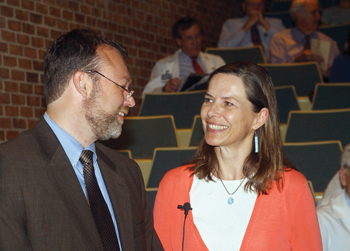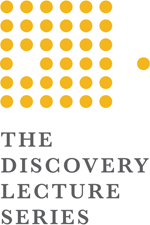
Discovery lecturer Agnes Fogo, M.D., talks with Jeffrey Balser, M.D., Ph.D., at last week’s presentation. (photo by Susan Urmy)
Lecture explores possibilities of reversing kidney damage

Chronic kidney disease, characterized by progressive scarring (sclerosis) of the kidney, is on the rise worldwide, and projections suggest an even steeper increase in the future.
The condition is “reaching astronomical proportions, particularly in diseases related to diabetes and hypertension,” said Agnes Fogo, M.D., professor of Pathology, Pediatrics, and Medicine in her March 29 Discovery Lecture.
Kidney transplants and dialysis can prolong life and slow the course of the disease. But, so far, we have not been able to actually reverse the persistent scarring associated with chronic kidney disease.
But there may be hope for reversing this damage, according to Fogo, who detailed the work of her lab and others in identifying the factors involved in kidney scarring and drugs that may reverse the damage.
Interestingly, she noted, many of the mediators of chronic kidney disease are modulated by the renin-angiotensin-aldosterone system, which is best known for its regulation of blood pressure.
So, researchers have been investigating the use of drugs that act on this system, including ACE (angiotensin converting enzyme) inhibitors (e.g., enalapril) and angiotensin receptor blockers (e.g., losartan).
In patients treated with ACE inhibitors, the progression of their kidney damage slowed, prolonging the time until they reached “end stage renal disease,” Fogo noted.
“So, if we can slow down the progression by inhibiting angiotensin…can we be so audacious to think that it is possible that, by giving them higher doses, that we can even reverse sclerosis?”
In animal studies, researchers have identified specific factors that may mediate scarring, including plasminogen activating factor 1(PAI-1) and plasmin, which may be also involved in the improvements seen with drugs targeting angiotensin.
“Supposing that the angiotensin-PAI-1 axis is very important for mediating progression of glomerular sclerosis and that if we antagonize angiotensin with very high doses, we can achieve regression of scarring, mediated at least in part by the effects of plasmin,” Fogo explained.
Using proteomic techniques, Fogo and colleagues have also identified an unexpected factor marker of sclerosis, thymosin beta-4, which has recognized roles in wound healing, angiogenesis and cardiac repair.
“These studies are wonderful for the rats and mice of the world,” Fogo quipped. “If you have a rodent that you care about, you can bring them to our lab, and we can do something about their kidney disease.”
Ending on an optimistic note, however, Fogo described a 10-year study by researchers at the University of Minnesota showing that diabetes patients who had pancreas transplants showed a striking reversal of glomerular sclerosis.
“So there is proof of principle that reversal of kidney scarring can also be reversed in humans as well.”
For a complete schedule of the Discovery Lecture Series and archived video of previous lectures, go to www.mc.vanderbilt.edu/discoveryseries.













